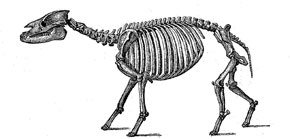Palaeotheriidae
 Pictured left: Reconstruction of the paleothere Promalaetherium. Reproduced with permission from Hellmund, M. (2005): A three-dimensional skeletal reconstruction of the Middle Eocene Propalaeotherium hassiacum Haupt 1925 (Equidea, Perissodactyla, Mammalia) and a modern synoptic painting of some individuals within their habitat . Kaupia (Darmastädter Beiträge zur Natureschichte), 14:15-20.
Pictured left: Reconstruction of the paleothere Promalaetherium. Reproduced with permission from Hellmund, M. (2005): A three-dimensional skeletal reconstruction of the Middle Eocene Propalaeotherium hassiacum Haupt 1925 (Equidea, Perissodactyla, Mammalia) and a modern synoptic painting of some individuals within their habitat . Kaupia (Darmastädter Beiträge zur Natureschichte), 14:15-20.
Palaeotheriidae: The Palaeotheres are very closely related to Hyracotherium. Early palaeotheres are often confused with primitive horses, although they belong to a separate Family. While the ancestors of the earliest horses lived in North America (and probably Asia), palaeotheres evolved in Europe and were confined to that continent until their extinction around 45 MYA. The earliest palaeotheres, such as Propalaeotherium, are almost indistinguishable from early horses, but their molars were slightly different and the pelvis and hind-limb bones suggest a less muscular hindlimb. Later palaeotheres, like Palaeotherium, were more tapir-like in size and shape. The retracted nasal bone suggests a tapir-like proboscis, and their three-toed limbs were rather short and stocky. Like tapirs, Palaeotherium was suited to walking through underbrush and wading through swampy ground Palaeotheres died out near the end of the Eocene and have no living descendants.


Left: Skeleton of the palaeothere Palaeotherium from the Eocene of Europe. Right: Skeleton of the palaeothere Propalaeotherium parvulum from Messel, Germany.


